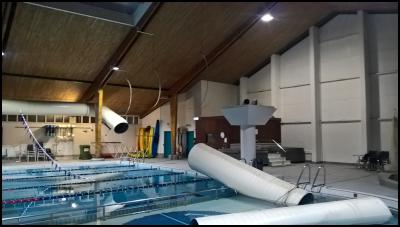Building Owners Ignoring Hidden Earthquake Danger
MEDIA RELEASE
18/11/2016

Photo caption: Monday’s
earthquake caused air conditioning ducts to collapse into
John Spry Pool in Johnsonville.
Building Owners Ignoring Hidden Earthquake Danger
Monday’s earthquake should be a wakeup call about the risks that building owners are ignoring, Quake Protected says.
The 7.8 magnitude earthquake struck near Culverden in Canterbury and caused severe damage to numbers of buildings in Wellington. Concern is high about the structural damage incurred, but people are ignoring the non-structural dangers, it claims.
“Large items falling from ceilings pose a serious danger to people’s lives, as well as dramatically increasing the cost of repairs. A lot of focus goes into the structural design of buildings to withstand earthquakes, but dangerous non-structural elements are regularly being overlooked”, said Jeremy Baker of Quake Protected.
The 111 call centre in Wellington was closed on Monday when ceiling tiles fell and an air conditioning unit crashed through a ceiling onto a desk.
“That air conditioning unit could have killed someone,” said Baker.
At John Spry swimming pool in Johnsonville huge air conditioning ducts fell into the pool.
"We were very lucky that no one was in the swimming pool,” said Wellington Mayor, Justin Lester.
These are examples of the hidden dangers that building owners often ignore, according to Baker.
“Ceiling elements such as air conditioning units, ceiling tiles and sprinkler systems need seismic restraining to save lives and decrease damage.”
Wellington engineer Terry Johnson runs Reveal Seismics, a company involved in non-structural seismic engineering such as ceilings, partitions, and ductings.
He said initial assessments suggest some of the buildings in Wellington failed in an earthquake that was only one-third of the intensity that the structures were designed to withstand.
"Some of those buildings are failing structurally and they are also failing from a non-structural view,” he said.
Another example was seen at Countdown Wainuiomata where ceiling tiles, lights and signs fell down. The supermarket was closed at the time of the earthquake, but Baker warns that the falling objects could have caused nasty injuries if the supermarket had been open.
Quake Protected are New Zealand’s largest specialist installer of non-structural seismic restraints and is working with the growing number of large corporates who are taking the risks seriously.
Earlier this year they worked with the University of Otago to seismically restrain a very large chandelier. The building had been renovated and a suspended ceiling meant that the chandelier was now out of sight, but still could have fallen in an earthquake. The proactive approach of University of Otago means that in the event of an earthquake, people underneath it will be safe.
“Staff members don't often think about the air conditioning units, lighting or ceiling tiles in the ceiling above their head that could fall down. But we saw some very real examples of that in yesterday’s earthquake,” said Baker.
“If office or supermarket workers want building owners to address these hidden dangers they should request that unrestrained ceiling items be added to the health and safety hazard register.”
“The next earthquake might not be during the night so we need to take the warnings now”, Baker said.
###
ENDS


 Federated Farmers: Government Ends War On Farming
Federated Farmers: Government Ends War On Farming University of Auckland: NZ Researchers Drive Work On International AI Framework
University of Auckland: NZ Researchers Drive Work On International AI Framework Woolworths: Rolling Out Team Safety Cameras To All Stores As Critical Tool For De-escalating Conflict
Woolworths: Rolling Out Team Safety Cameras To All Stores As Critical Tool For De-escalating Conflict  Consumer NZ: Environmentally Conscious Shoppers At Risk Of Being Greenwashed
Consumer NZ: Environmentally Conscious Shoppers At Risk Of Being Greenwashed Hugh Grant: Facing The Future - The Use Of Biometric Tech
Hugh Grant: Facing The Future - The Use Of Biometric Tech John Mazenier: Gaffer Tape And Glue Delivering New Zealand’s Mission Critical Services
John Mazenier: Gaffer Tape And Glue Delivering New Zealand’s Mission Critical Services



